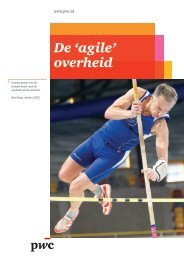Toekomst voor aanvullende pensioenen
Toekomst voor aanvullende pensioenen
Toekomst voor aanvullende pensioenen
- No tags were found...
Create successful ePaper yourself
Turn your PDF publications into a flip-book with our unique Google optimized e-Paper software.
Taking the Dutch pension system to the next level: a view from the outside1. Create a protocol to convert current accrued collective pension rights ofplan participants into Tinbergen Model pension rights: This protocolneeds to pass the triple tests of understandability, legality, and bothactual and perceived fairness to all participants. Devising such a protocolwill be exacting work. For example, the conversion process could startby dividing up plan assets on a given date into individual plan memberownership rights. 43 Once these ‘divvying-up’ calculations are agreed to,the plan’s age-based default allocation rule is used to allocate each planparticipant’s asset rights between the ‘return-seeking’ and ‘safety’ componentsof the new plan. 44 These notional default allocations are communicatedto plan participants with a clear explanation of the different goalsof the two components. Participants have an option to adjust the defaultsplits in line with their own preferences if they differ from the defaultcalculation. The current legal plan entity becomes the ‘safety’ componentin the new Tinbergen Model. A new return-seeking component is createdin which plan participants are allocated ownership units in line with theirownership rights and their default (or chosen) allocation.2. Re-write pension laws to ensure the Tinbergen Pension Model and theconversion protocol to adopt it are legal: This will require legal expertise,common sense, and a ‘greater good’ solidarity philosophy. For example,current Dutch pension law requires full annuitization at retirement, anddoes not permit changes in the make-up of plan benefits unless theymeet a broad ‘for the greater good/fairness’ test.3. Engage pension plan participants in the process: The transition to theTinbergen Pension Model (and an agreed-on conversion protocol toget there) will not happen without broad ‘average citizen’ support. This4143 This ‘divvying-up’ process of a fund’s assets could be guided by calculating the present valuesof the accrued participant benefits in the current pension plan on the conversion date, as wellas the accumulated values of member contributions plus an earned rate of interest on them.Because of the ‘doorsneepremie’ feature in many plans, the contributions (plus interest) ofactive workers will exceed the present value of their accrued benefits. An average of these twocalculations might offer a reasonable basis for establishing ‘fair’ participant ownership rightproportions to the fund’s assets. Likely, a good dose of ‘solidarity’ will be needed in many plansto reach agreement on the fairest way to ‘divvy up’ pension plan assets on a specific date.44 So, following the default allocation rule set out earlier, 100% of the asset ownership rights ofmembers aged 47 or younger would go into the return-seeking pool, while only 20% of therights of members aged 67 or older would go into the return-seeking pool, with the other 80%allocated to the annuity pool. The proportions of the 47-67 age-group are proportionally inbetweenthese two weighting schemes. As noted earlier, plan members would have the optionto override these initial default allocations.




![Proefschrift Hanneke A. Luth[lr]](https://img.yumpu.com/51055008/1/178x260/proefschrift-hanneke-a-luthlr.jpg?quality=85)

![Proefschrift Hanneke A. Luth[lr]](https://img.yumpu.com/24018368/1/178x260/proefschrift-hanneke-a-luthlr.jpg?quality=85)